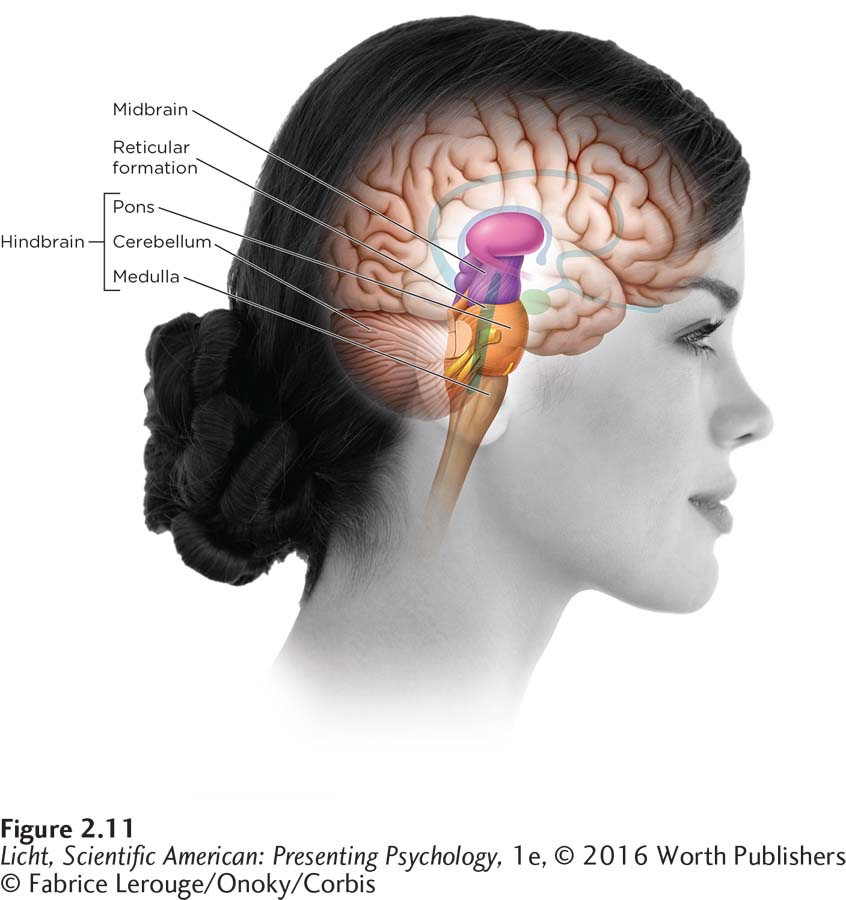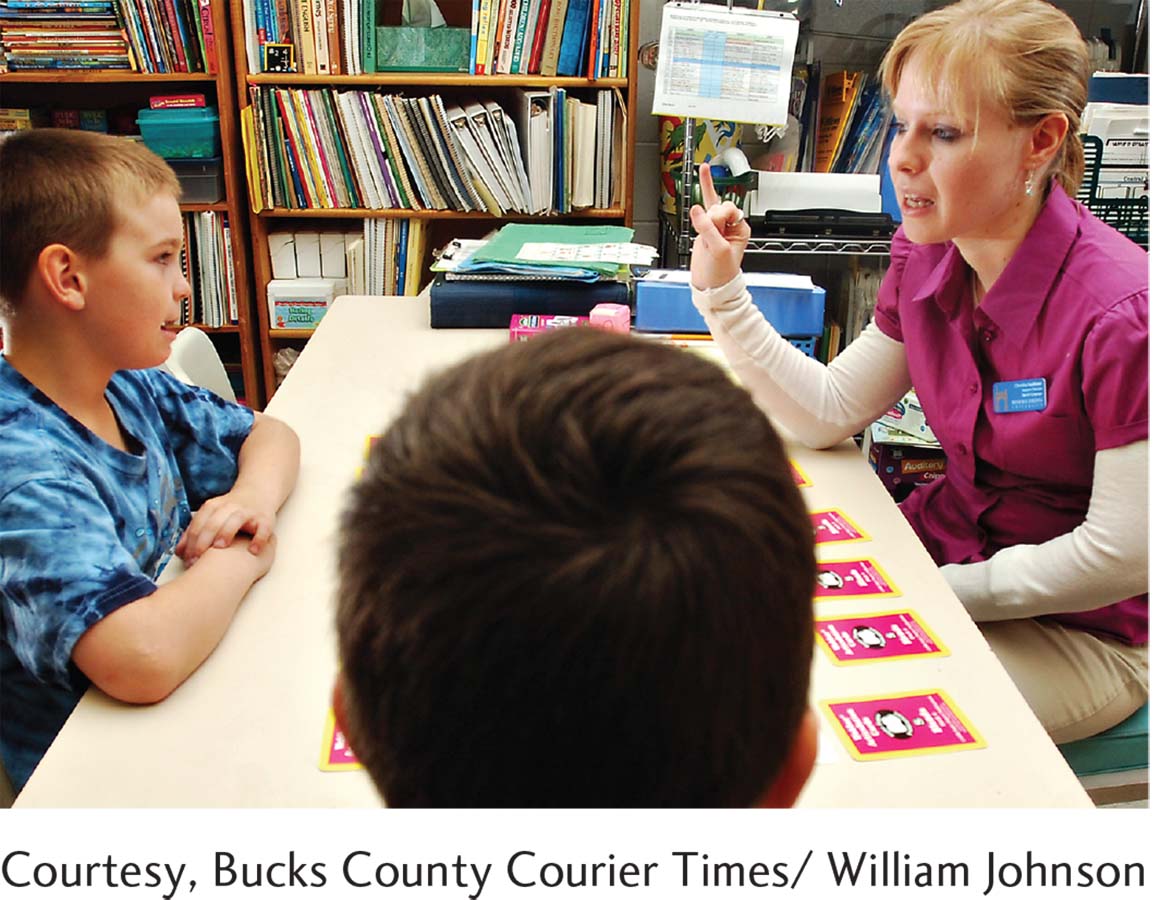2.5 Digging Below the Cortex
79
Now that we have surveyed the brain’s outer terrain, identifying some of the hotspots for language and other higher cognitive functions, let’s dig deeper and examine some of its older structures.
Drama Central: The Limbic System
LO 15 Distinguish the structures and functions of the limbic system.
limbic system A collection of structures that regulates emotions and basic drives like hunger, and aids in the creation of memories.
Buried beneath the cortex is the limbic system, a group of interconnected structures that play an important role in our experiences of emotion, motivation, and memory. It also fuels our most basic drives, such as hunger, sex, and aggression. The limbic system includes the hippocampus, amygdala, thalamus, and hypothalamus (Figure 2.10).

The limbic system fuels basic drives and processes emotions and memories.
hippocampus A pair of structures located in the limbic system; primarily responsible for creating new memories.
HIPPOCAMPUS The largest structure in the limbic system is the hippocampus, a pair of curved structures. The hippocampus is primarily responsible for processing and forming new memories from experiences, but it is not where memories are permanently stored (Eichenbaum, 2004). Given its key role in memory, it may come as no surprise that the hippocampus is one of the brain areas affected by Alzheimer’s disease (Henneman et al., 2009; Wang et al., 2003). On the brighter side of things, the hippocampus is also one of the few places in the brain known to generate new neurons throughout life (Eriksson et al., 1998; Tate, Herbet, Moritz-
amygdala (ə-mig-
AMYGDALA Another structure of the limbic system is the amygdala (ə-mig-
80
thalamus (tha-
THALAMUS Seated at the center of the limbic system is the thalamus (tha-
hypothalamus (hī-pō-tha-
HYPOTHALAMUS Just below the thalamus is the hypothalamus (hī-pō-tha-
Deeper Yet: The Brainstem and Cerebellum
The brain is made up of structures responsible for processes as complex as rebuilding a car’s engine or selecting the right classes for a degree program. Yet delving deeper in the brain, we find structures that control more primitive functions.
LO 16 Distinguish the structures and functions of the brainstem and cerebellum.
forebrain Largest part of the brain; includes the cerebral cortex and the limbic system.
COMPONENTS OF THE BRAINSTEM The brain’s ancient core consists of a stalklike trio of structures called the brainstem (Figure 2.11). The brainstem, which includes the midbrain, pons, and medulla, extends from the spinal cord to the forebrain, which is the largest part of the brain and includes the cerebral cortex and the limbic system.
midbrain The part of the brainstem involved in levels of arousal; responsible for generating movement patterns in response to sensory input.
reticular formation A network of neurons running through the midbrain that controls levels of arousal and quickly analyzes sensory information on its way to the cortex.
Synonyms
reticular formation reticular activating system
The top portion of the brainstem is known as the midbrain, and although there is some disagreement about which brain structures belong to the midbrain, most agree it plays a role in levels of arousal. The midbrain is also home to neurons that help generate movement patterns in response to sensory input (Stein, Stanford, & Rowland, 2009). For example, if someone shouted “Look out!” neurons in your midbrain would play a role when you flinch. Also located in the midbrain is part of the reticular formation, an intricate web of neurons that is responsible for levels of arousal—
hindbrain Includes areas of the brain responsible for fundamental life-
pons A hindbrain structure that helps regulate sleep–
medulla (mə-ˈdu̇l-

Located beneath the structures of the limbic system, the brainstem includes the midbrain, pons, and medulla. These structures are involved in arousal, movement, and life-
The hindbrain includes areas of the brain responsible for fundamental life-
81
cerebellum (ser-
CEREBELLUM Behind the brainstem, just above the nape of the neck, sits the orange-
Hooray! We have finally completed our tour of the nervous system. We started on the micro level, exploring electrical and chemical signaling between neurons, and then worked our way through the macro structures of the brain, spinal cord, and peripheral nervous system. As you delve into topics covered in other chapters, remember that communication between neurons underlies every psychological phenomenon. Do not hesitate to revisit this chapter throughout the course; this is your biological foundation.
show what you know
Question 1
1. The ____________ is a group of interconnected structures that process emotions, memories, and basic drives.
left hemisphere
limbic system
corpus callosum
superior temporal sulcus
b. limbic system
Question 2
2. The specific brain structure that processes basic emotions, such as fear and aggression and the memories associated with them, is the ____________.
amygdala
Question 3
3. The primary role of the thalamus is to:
relay sensory information.
keep the body’s systems in a steady state.
generate movement patterns in response to sensory input.
regulate sleep–
wake cycles.
a. relay sensory information.

Three years after his traumatic brain injury, Brandon celebrated his marriage to Laura. The couple now has three children.
 WHERE ARE THEY NOW? You may be wondering what became of Brandon Burns and Christina Santhouse. Three years after returning from Iraq, Brandon married a young woman named Laura who has witnessed his dramatic recovery. When Laura first met Brandon, he had a lot of trouble communicating his thoughts. His sentences were choppy; he often omitted words and spoke in a flat and emotionless tone. “His speech was very delayed, very slow,” Laura recalls. Now he is able to use more humor and emotion, articulate his thoughts in lengthy, complex sentences; read a book; and write for his Web site. Much of Brandon’s time is spent caring for his sons, 6-
WHERE ARE THEY NOW? You may be wondering what became of Brandon Burns and Christina Santhouse. Three years after returning from Iraq, Brandon married a young woman named Laura who has witnessed his dramatic recovery. When Laura first met Brandon, he had a lot of trouble communicating his thoughts. His sentences were choppy; he often omitted words and spoke in a flat and emotionless tone. “His speech was very delayed, very slow,” Laura recalls. Now he is able to use more humor and emotion, articulate his thoughts in lengthy, complex sentences; read a book; and write for his Web site. Much of Brandon’s time is spent caring for his sons, 6-
 As for Christina, she continues to reach for the stars—
As for Christina, she continues to reach for the stars—

With her master’s degree in speech–
82

Today, Christina works as a full-
Brandon and Christina provide breathtaking illustrations of neuroplasticity—